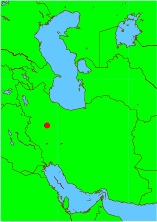|
|

Hamadan / Ecbataba Ecbatana (Haŋgmatana in Old Persian, Agbatana in Aeschylus, written Agámtanu by Nabonidos, and Agamatanu at Behistun) was the capital of Astyages (Istuvegü), which was taken by the Persian emperor Cyrus the Great in the sixth year of Nabonidos (549 BC). The city is now known as Hamadan and is located 400 km southwest of Tehran, in modern day Iran (Persia). The Greeks supposed it to be the capital of Media, and ascribed its foundation to Deioces (the Daiukku of the cuneiform inscriptions), who is said to have surrounded his palace in it with seven concentric walls of different colours. Under the Persian kings, Ecbatana, situated at the foot of Mount Elvend, became a summer residence. Later, it became the capital of the Parthian kings.H Rawlinson attempted to prove that there was a second and older Ecbatana in Media Atropatene on the site of the modern Takht-i-Suleiman, but the cuneiform texts imply that there was only one city of the name, and Takht-i Suleiman is the Gazaca of classical geography. Ecbatana was the main mint of the Parthians, it produced drachm, tetradrachm, and assorted bronze denominations. Ecbatana/Hamadan (Iran) is not to be confused with Ecbatana/Hamath (Syria) where Cambyses II is supposed to have died according to Herodotus. References See Perrot and Chipiez, History of Art in Persia (Eng. trans., 1892); M Dieulafoy, L'Art antique de Ia Perse, pt. i. (1884); J. de Morgan, Mission scientifique en Perse, ii. (1894). Retrieved from "http://en.wikipedia.org "
 |
|
|||||||||||||||||